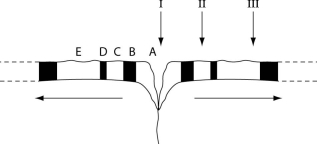The following questions refer to the description and figure below.
The figure represents a cross section of the sea floor through a mid-ocean rift valley, with alternating patches of black and white indicating sea floor with reversed magnetic polarities. At the arrow labeled "I" (the rift valley) , the igneous rock of the sea floor is so young that it can be accurately dated using carbon-14 dating. At the arrow labeled "III," however, the igneous rock is about 1 million years old, and potassium-40 dating is typically used to date such rocks. Note: The horizontal arrows indicate the direction of sea-floor spreading, away from the rift valley.

Figure 25.1
-If a particular marine organism is fossilized in the sediments immediately overlying the igneous rock at the arrow labeled "II," at which other location, labeled A-E, would a search be most likely to find more fossils of this organism?
Definitions:
Parasympathetic Division
A branch of the autonomic nervous system responsible for conserving energy and promoting a state of relaxation, often referred to as the "rest and digest" state.
Wernicke's Area
A region of the brain that is important for language development and is located in the posterior part of the temporal lobe on the left side of the brain. It is involved in the comprehension of speech.
Receptive Aphasia
A neurological condition characterized by difficulties in understanding spoken or written language, despite normal speech production abilities.
Expressive Aphasia
A neurological condition characterized by the impaired ability to produce language, despite often retaining comprehension abilities.
Q12: In order for speciation to occur,what must
Q22: What is an early step in shotgun
Q22: The same gene that causes various coat
Q45: If the experimental population of E.coli lacks
Q46: Currently,two extant elephant species (X and Y)are
Q55: Antiviral drugs that have become useful are
Q56: The appearance of Pax-6 in all animals
Q62: In the formula for determining a population's
Q68: Which statement about variation is true?<br>A)All phenotypic
Q73: Which of the following statements does not